On my structural geology field trip this past weekend, I made one major modification compared to last year’s iteration. I added a fifth detailed “field study area” at an outcrop of the Swift Run Formation, a Neoproterozoic sedimentary unit that is discontinuous in extent between the underlying Blue Ridge basement complex and overlying Catoctin Formation meta-basalts. A month ago, I didn’t know about this location, but I was introduced to it by Chuck Bailey on the Transect Trip last month. It’s a perfect complement to my structure students’ detailed examinations of the units above and below it, and the outcrop offers an embarrassment of rich structures to measure, both primary and secondary.
Here’s something I spent some time pondering: are there ball-&-pillow structures preserved in the Swift Run? We definitely see the ‘coarse-sand-dumped-on-mud’ set up that will lead to soft sediment deformation (sagging of heavy sand downward into squishy mud) under the right circumstances.
Okay, so with that in mind, take a look at this:
You’ll notice a clear contact here between dark, fine-grained mud (below) and lighter-colored arkose sand (above). The contact is irregular, so a sedimentologist unschooled in structure might start thinking about soft sediment deformation. But it’s not so simple as that: this rock is cleaved! The photo above is looking down parallel to the cleavage plane. Annotations:
The boundary between the two strata tends to get a bit scrambled at this interface, with an increasingly zig-zaggy trace as deformation proceeds. Now, let’s rotate the same sample by 90°, and check out the trace of the bedding on the cleavage plane itself:
Pretty smooth line, eh? Not nearly so “EKG-ish” as what we observed in the first photo. This suggests that the wigglyness we saw in the first photo is a structural overprint, and not a primary sedimentary feature. We can then breath a sigh of relief, and just use this cleavage plane outcrop to point out what a nice graded bedding contact looks like:
Here’s a second sample, as viewed on the edge where cleavage and bedding intersect. The little white dot is some kind of arthropod egg case; ignore it.
Whoa! significantly more up and down wiggles here to the contact between the two beds. Again, this could be a primary feature (soft sediment deformation), or it could be a structural overprint caused by the development of crenulation cleavage. I note how the bottom of the tan bed shows the large-amplitude wiggles, but the top does not. Now let’s turn this one 90° so we’re facing the cleavage face, and see what we see there:
Some annotations:
I would not expect a structural re-organization of the bedding trace as viewed on the plane of foliation, only 90° to it. So the fact that the second sample shows the wiggles continuing around all exposed faces suggests to me that it is indeed a primary feature, but the alignment of the most-vertical parts of the sags was accentuated by the development of cleavage, as seen on the first face. This interpretation is backed up by the observation that the basal part of the sandy unit (the coarsest part) varies not only in position, but also in thickness as you trace it out around all sides of the sample.
I’m not entirely satisfied with this interpretation though, because of the asymmetry and small-scale “parasitic” wiggles on each of the potential sand “pillows.” Furthermore, when I’ve seen true ball-&-pillow soft-sediment deformation structures in the field, the mud that squishes up is typically in a cuspate form, in stark contrast to the lobate blobs of sand that sink down. Here in this Swift Run sample’s foliation plane, the shape character of the ups appears to match the shape character of the downs. On the first view (looking parallel to the bedding/cleavage intersection), however, I suppose one could argue that the mud approximates a flame structure (cuspate) while the sand pillows look more lobate… but with the cleavage overprint, it sure isn’t super obvious.
Anyone else want to chime in on these two samples? Observations? Interpretations?

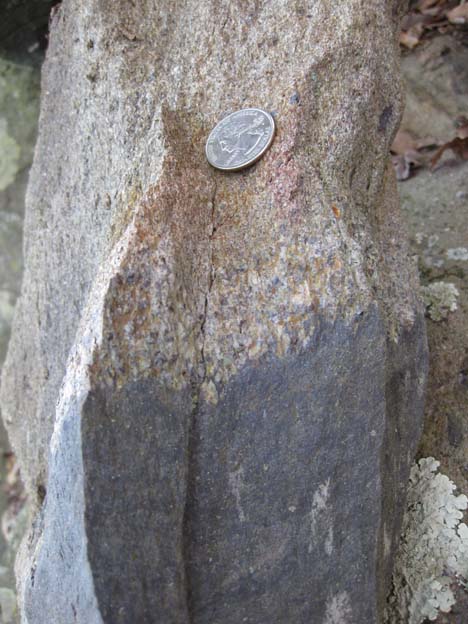
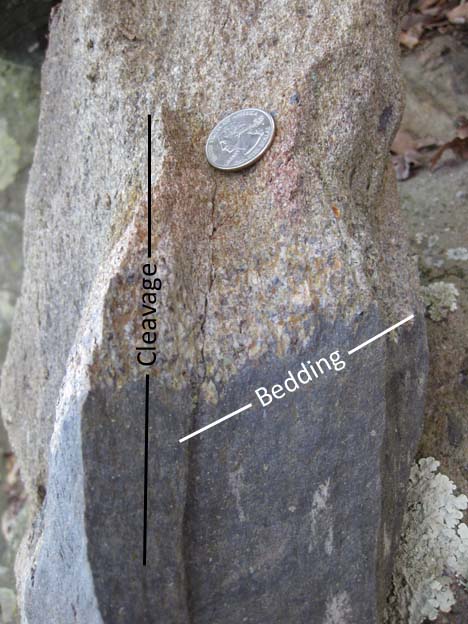
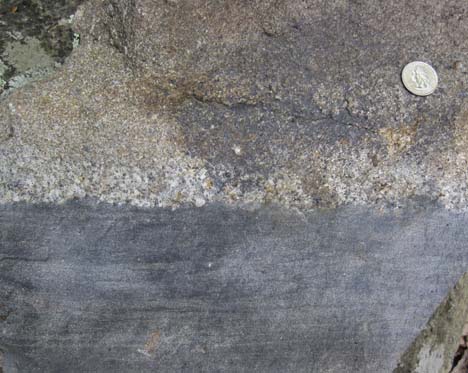
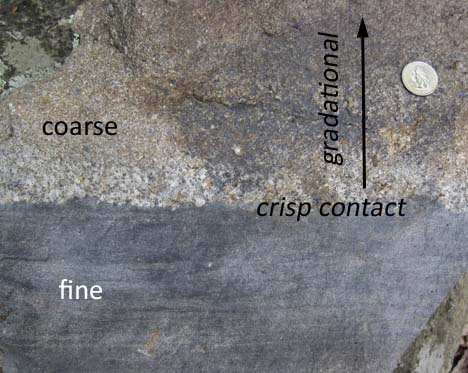
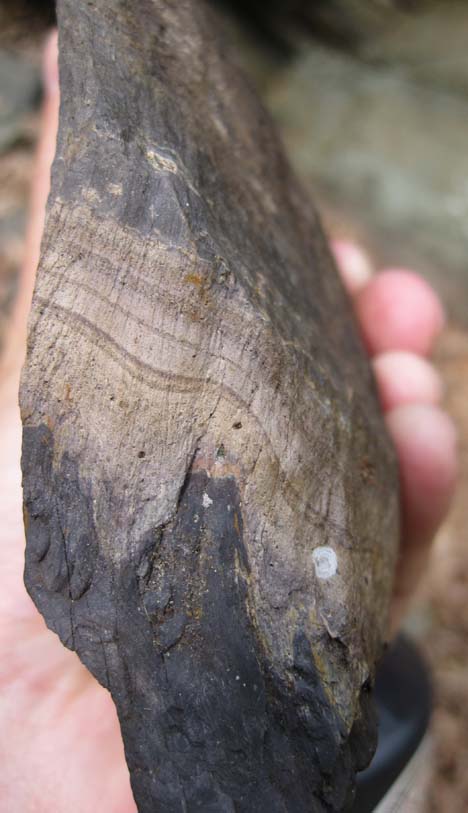
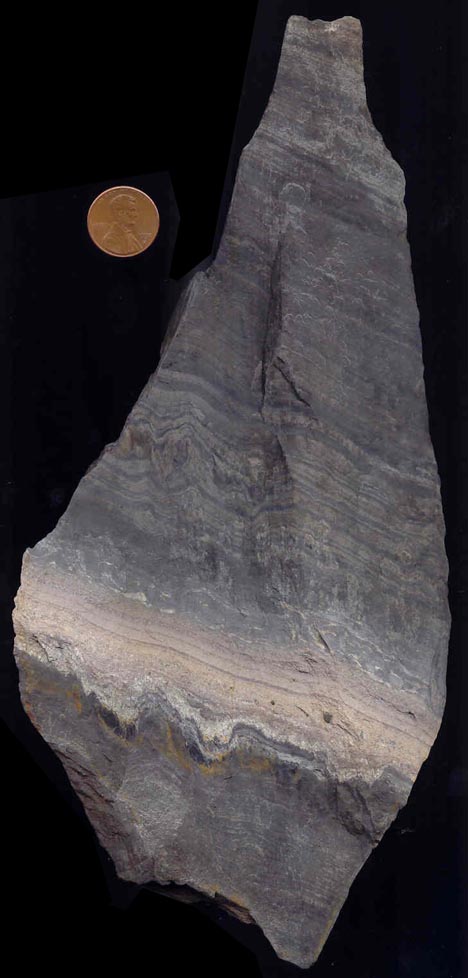
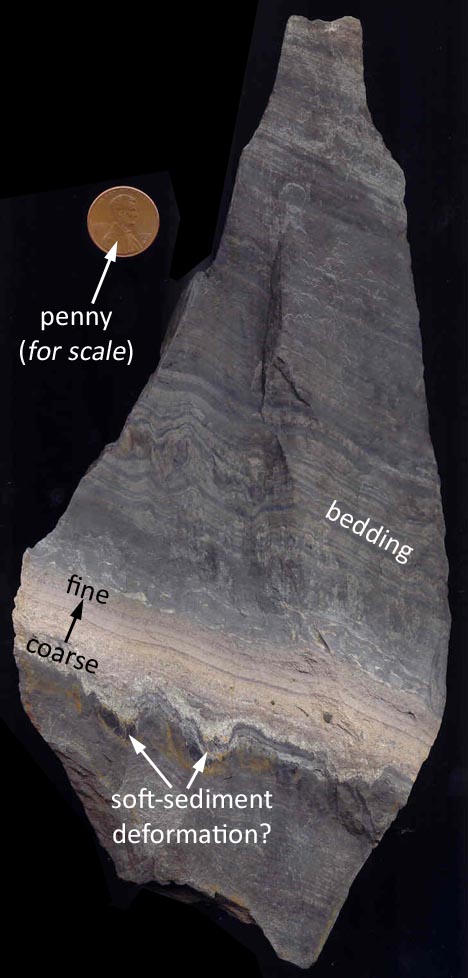
This is a tough one … my experience has led me to see a boatload of soft-sediment deformation but very few examples of cleavage. So, I feel like I might be biased. But, it sure looks like soft-sed def, especially in the lower one. If it were an overprint how come the upper boundary between sand and mud isn’t affected?
And then whenever there are two hypotheses, there’s always a third — it’s a combination of both!
Cool stuff.
Another possibility that comes to mind, especially when you’re dealing with a coarse, graded bed abruptly overlying mud, is that it’s an irregular scour-and-fill surface. This would account for the variable thickness of the basal coarse arkose bed, which may have filled in the irregular scour surface “valleys”, then was overlain by the more evenly thick, progressively finer sediments, which might show some primary drape at the bottom, gradually flattening out with increasing distance above the scour surface.
In the case of scour-and-fill, you wouldn’t expect the waviness to continue into the lower (mud) bed–it’s hard for me to tell from the photos (5 & 6) how wavy or not the mud bed is. Of course, it doesn’t have to be an “either/or” situation; you could conceivably get a “hybrid” scouring and filling on an unconsolidated surface that had a soft-sed deformation component, too. Structural overprinting could then have contributed the “global waviness” that extends through both the mud and the sand. Hmmmm. Rocks. Gotta love ’em!
Cheers,
–Howard